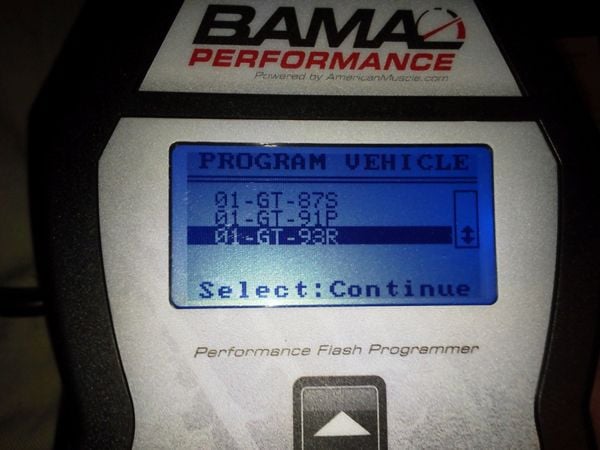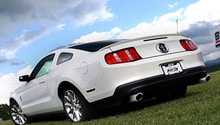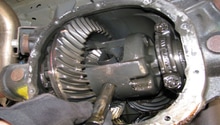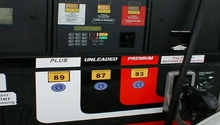Ford Mustang GT 1996-2004: Engine Tuning Information
Tuning of the powertrain control module has become a cornerstone in the aftermarket automotive industry. With a wide selection of handheld tuners on the market, optimizing your engine's tune to increase horsepower, torque, and throttle response has never been easier.
This article applies to the Ford Mustang GT (1996-2004).
Since the advent of electronic ignition and fuel injection, the aftermarket has been set ablaze by performance engine tuning. Modern engines are almost entirely controlled by the powertrain control module (PCM), which optimizes things like fuel trims, ignition timing, and throttle response. The Mustang's tune, or map, in the PCM is known to be rather conservative when it leaves the Ford factory because the vehicle must meet fuel consumption and emissions standards. Aftermarket handheld engine tuners are available to re-map the parameters in the PCM to allow for increased horsepower and torque while still providing a high level of reliability and fuel mileage. While an aftermarket tune will increase performance on a stock Mustang, cars with various performance modifications traditionally see greater power increases because the tune can be optimized for the specific parts installed on the car. An added benefit to a handheld tuner is that they are capable of data logging critical engine information, as well as clearing diagnostic trouble codes. This article will give an overview of performance engine tuning for 1996 to 2004 Mustang GT models.
Component Breakdown
Handheld Tuner
When you purchase a performance tuner, you will receive a handheld device like the one pictured in Figure 1. The tuner communicates to the PCM by connecting to the on-board diagnostic port located under the dash on the driver's side. Many tuners come with a color LCD display and often include Wi-Fi to download tunes and send data-logging information. These tuners are compact enough to fit in the glove box and can be used to load tunes at any time or retrieve diagnostic fault codes. Many individuals opt to mount their tuner on the dash or windshield to allow for regular monitoring of various engine parameters.

Tuning Files
The main aspect of any tuner is the tuning file or map. Most tuners will hold various files that can be applied to the vehicle at any time. Many tuners come pre-programmed with an off-the-shelf tune that will work well for many applications. Similarly, certain tuners will allow you to hand select a tuning file based on the specific bolt-on modifications that are equipped to your vehicle. For the ultimate performance increase, a custom tune can be created specifically for your vehicle; however, extensive data-logging and a dynomometer experience are typically required to properly dial things in.

Common Questions
Is a tuner difficult to use?
Generally speaking, tuners are very user-friendly and allow for quick as well as easy changes to be made to the PCM for increased performance. Basically, if you can operate today's smartphones, you will have no trouble applying a tune to your car. That being said, some tuners (typically laptop-based) not only apply pre-made tunes, but allow the user complete control over the vehicle's PCM. Custom tuning should only be completed by an expert, as changing the wrong parameters can result in drivability issue or engine damage.
How much horsepower will I gain?
Most off-the-shelf tunes will provide a 10 to 15 horsepower gain for stock vehicles. Many tuning companies offer a semi-custom tune by asking you a series of questions about the mods, fuel quality, and intended usage of your vehicle to further improve the tune. Companies like Bama Performance claim they can provide a true 20 rear wheel horsepower increase by matching a tune to your car. Larger performance gains can be seen on cars that have additional bolt-on modifications. Regardless of peak horsepower numbers, aftermarket tunes produce torque and horsepower increases throughout the power band and greatly improve throttle response.
How exactly does a tune achieve these performance increases?
Simply put, the PCM monitors various engine sensors and is calibrated to deliver the correct fuel as well as ignition timing based on the the readings of these sensors. The factory PCM parameters are fairly conservative in order to meet fuel and emissions standards. A tune modifies the parameters in the PCM to allow for increased fueling and advanced ignition timing, among other changes, to greatly improve performance in aggressive driving situations . On top of a boost in power, tunes have also shown to decrease fuel consumption because they tend to improve low to mid-range power delivery. For those pinching their pennies at the pump, many tuners offer an economy tune that further decreases fuel consumption by limiting fuel supply and retarding ignition timing.
What is the difference between an off-the-shelf tune and a custom tune?
An off-the-shelf tune, sometimes referred to as a "canned" tune, is a tune created to be quickly applied to the vehicle for a slight bump in power or fuel economy with little regard to the vehicle's modifications. A semi-custom tune, as described above, is when a tuner or tuning company optimizes a tune to for the specific modifications installed on your vehicle (i.e. exhaust. throttle body, etc). This is done remotely, and while not ideal, is generally preferred over a canned tune. A full custom tune is generally created specifically for your vehicle. More often than not, the car is placed on a dyno and various engine parameters are logged as well as adjusted as the vehicle is put through its paces. That being said, data-logging has allowed individuals to perform various on-road tests and send recorded log files to a tuner where a custom tune is then written for the specific car.
What type of tune is best for me?
For 90% of enthusiasts, a semi-custom tune is the best option for a moderately modded car, as much of the cars potential can be unleashed at a fraction of the cost of a custom tune. For individuals with heavy modifications, such as turbochargers, superchargers, nitrous, or engines with heavy internal modifications, a custom tune is recommended to dial-in the extra fueling and ignition demands.
Can I use a tuner on multiple vehicles?
Tuning files are typically VIN-locked to the first vehicle they are used on and cannot be transferred to other vehicles.
How long does it take to tune my car?
Once you have a tuning file on hand and the tuner connected to the car, applying the tune (aka "flashing") takes only few minutes.
Will my car pass smog with an aftermarket tune?
Although tunes are intended for off-road use only, many owners report that an aftermarket tune has had no ill effects during emissions testing. A tuner also allows you to revert back to your factory tune at any time if necessary.
Are there any additional benefits to a owning a performance tuner that I should know about?
Yes! Besides applying engine tunes, data-logging, and reading/clearing diagnostic trouble codes, many handheld tuners provide owners the ability to adjust the engine rev limiter, vehicle speed limiter (if applicable), automatic transmission shift characteristics, cooling fan operating temperature, and speedometer calibration. Additionally, some tuners will allow individuals to manually adjust fuel tables and ignition timing.
Featured Video: Mustang SCT Tuner Tech
Related Discussions
- Advancing Spark Using an SCT Tuner - MustangForums.com
- HP Gains with Tuner - MustangForums.com
- Question About Selling Used Tuner - MustangForums.com






